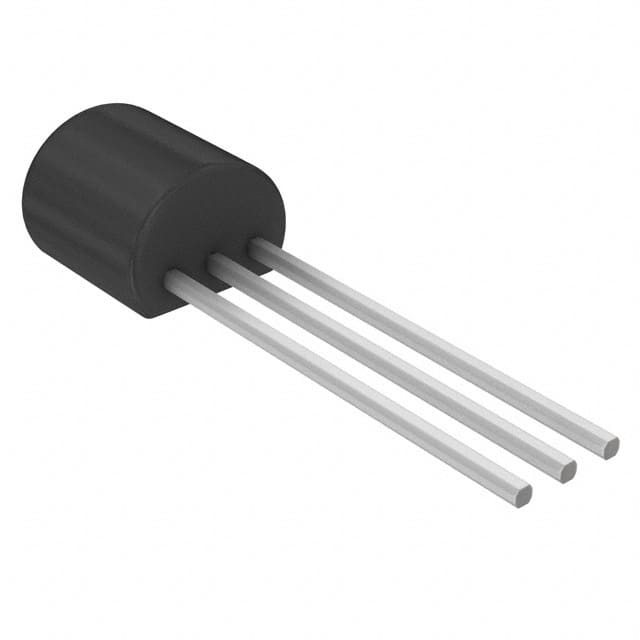LM385Z-1.2
Overview
Product Category
LM385Z-1.2 belongs to the category of voltage references.
Use
It is primarily used as a precision voltage reference in various electronic circuits.
Characteristics
LM385Z-1.2 exhibits the following characteristics: - High accuracy - Low temperature coefficient - Low power consumption - Wide operating voltage range - Good long-term stability
Package
The LM385Z-1.2 is available in a TO-92 package, which is a small plastic package with three leads.
Essence
The essence of LM385Z-1.2 lies in its ability to provide a stable and precise voltage reference for other components in an electronic circuit.
Packaging/Quantity
The LM385Z-1.2 is typically packaged in reels or tubes, containing a specific quantity of units per package.
Specifications
LM385Z-1.2 has the following specifications:
- Output Voltage: 1.2V
- Initial Accuracy: ±0.5%
- Temperature Coefficient: 20ppm/°C
- Operating Current: 10µA (typical)
- Operating Temperature Range: -40°C to +85°C
Pin Configuration
The LM385Z-1.2 has three pins arranged as follows:
```
| | --| VOUT |-- --| GND |-- --| VIN |-- |_______| ```
Functional Features
The LM385Z-1.2 offers the following functional features:
- Precise voltage reference for analog-to-digital converters
- Stable reference voltage for voltage regulators
- Reference source for current sources and current mirrors
- Biasing element for operational amplifiers
Advantages and Disadvantages
Advantages
- High accuracy ensures reliable performance in precision applications.
- Low temperature coefficient minimizes voltage drift with temperature changes.
- Low power consumption helps conserve energy in battery-powered devices.
- Wide operating voltage range allows for versatile use in various circuits.
- Good long-term stability ensures consistent performance over time.
Disadvantages
- Limited output voltage options restrict its use in certain applications requiring different reference voltages.
- The TO-92 package may not be suitable for all circuit designs, especially those with space constraints.
Working Principles
The LM385Z-1.2 is based on a bandgap voltage reference principle. It utilizes the inherent voltage characteristics of semiconductor materials to generate a stable reference voltage. This voltage is then used as a comparison standard for other components in the circuit.
Detailed Application Field Plans
LM385Z-1.2 finds application in various fields, including but not limited to: - Precision measurement equipment - Data acquisition systems - Voltage regulators - Analog and mixed-signal circuits - Sensor interfaces
Detailed and Complete Alternative Models
Some alternative models that can be considered as alternatives to LM385Z-1.2 are: - LM4040 - LT1004 - REF02 - MAX6126
These models offer similar functionality and specifications, providing alternative options for voltage reference requirements.
In conclusion, LM385Z-1.2 is a precision voltage reference component with high accuracy, low temperature coefficient, and wide operating voltage range. Its compact TO-92 package makes it suitable for various electronic circuits. While it has limitations in terms of output voltage options, it offers several advantages such as low power consumption and good long-term stability. Its working principle is based on the bandgap voltage reference concept. LM385Z-1.2 finds application in precision measurement equipment, data acquisition systems, voltage regulators, and more. Alternative models like LM4040, LT1004, REF02, and MAX6126 can be considered for similar requirements.
Lista 10 Vanliga frågor och svar relaterade till tillämpningen av LM385Z-1.2 i tekniska lösningar
What is the LM385Z-1.2?
The LM385Z-1.2 is a precision voltage reference diode that provides a stable 1.2V output voltage.What are the typical applications of LM385Z-1.2?
The LM385Z-1.2 is commonly used in precision voltage and current measurement circuits, as a reference for analog-to-digital converters, and in battery-powered systems.How accurate is the output voltage of LM385Z-1.2?
The LM385Z-1.2 has a typical initial accuracy of ±1% at 25°C, with low temperature coefficient and long-term stability.Can the LM385Z-1.2 be used in automotive applications?
Yes, the LM385Z-1.2 is suitable for automotive applications due to its wide operating temperature range and low power consumption.What is the maximum current that can be drawn from the LM385Z-1.2?
The LM385Z-1.2 can typically supply up to 15mA of output current while maintaining its specified performance.Is the LM385Z-1.2 available in different package types?
Yes, the LM385Z-1.2 is available in various package options, including TO-92 and SOT-23.Can the LM385Z-1.2 operate from a single supply voltage?
Yes, the LM385Z-1.2 can operate from a single supply voltage, making it suitable for battery-powered and portable devices.What are the key advantages of using the LM385Z-1.2 in technical solutions?
The LM385Z-1.2 offers low cost, high accuracy, low power consumption, and ease of use, making it ideal for precision voltage reference applications.Are there any specific considerations for PCB layout when using the LM385Z-1.2?
Proper grounding and decoupling techniques should be employed to ensure stable and accurate operation of the LM385Z-1.2 in PCB layouts.Where can I find detailed application notes and design resources for the LM385Z-1.2?
Detailed application notes, datasheets, and design resources for the LM385Z-1.2 can be found on the manufacturer's website or through authorized distributors.


